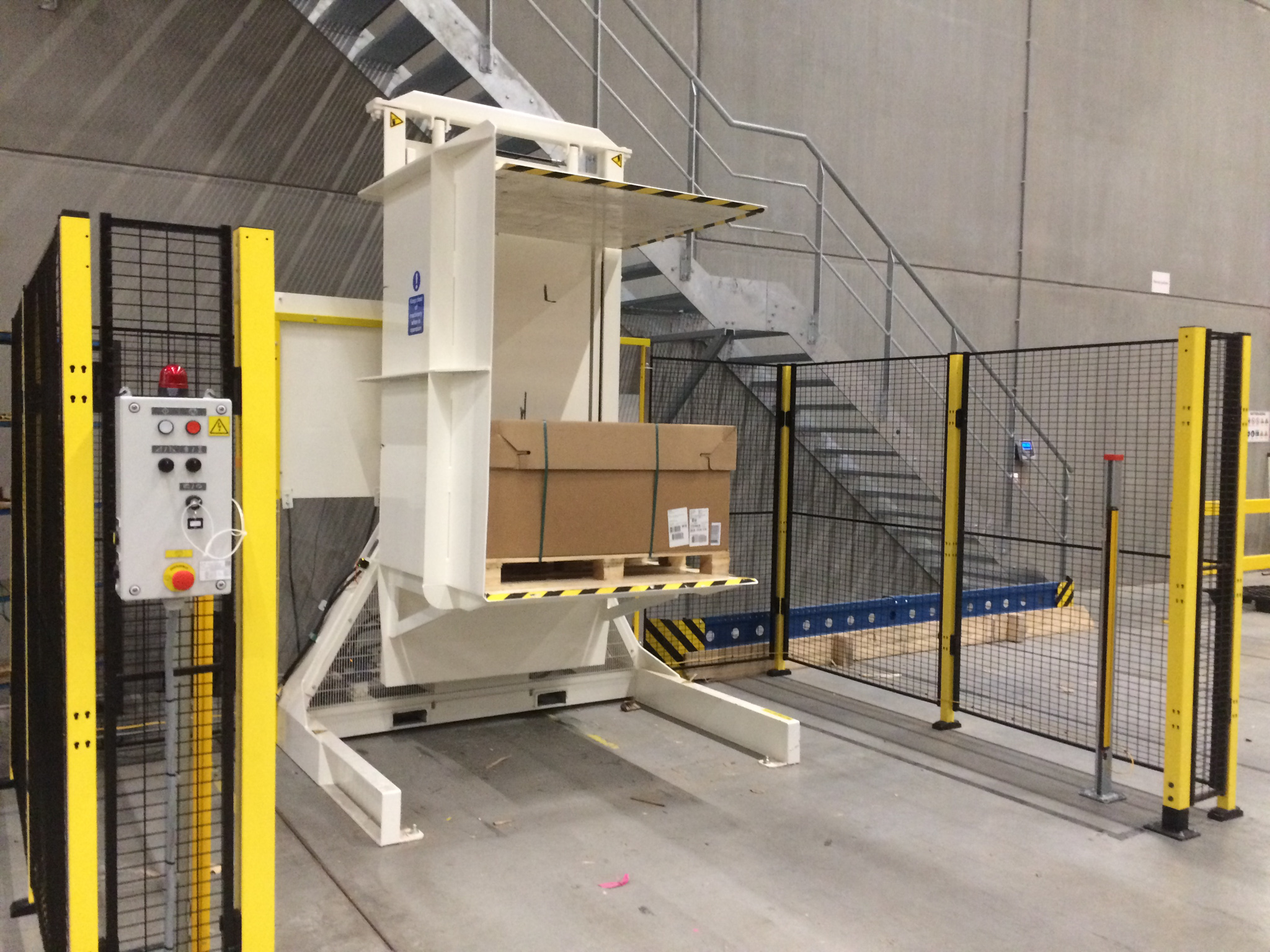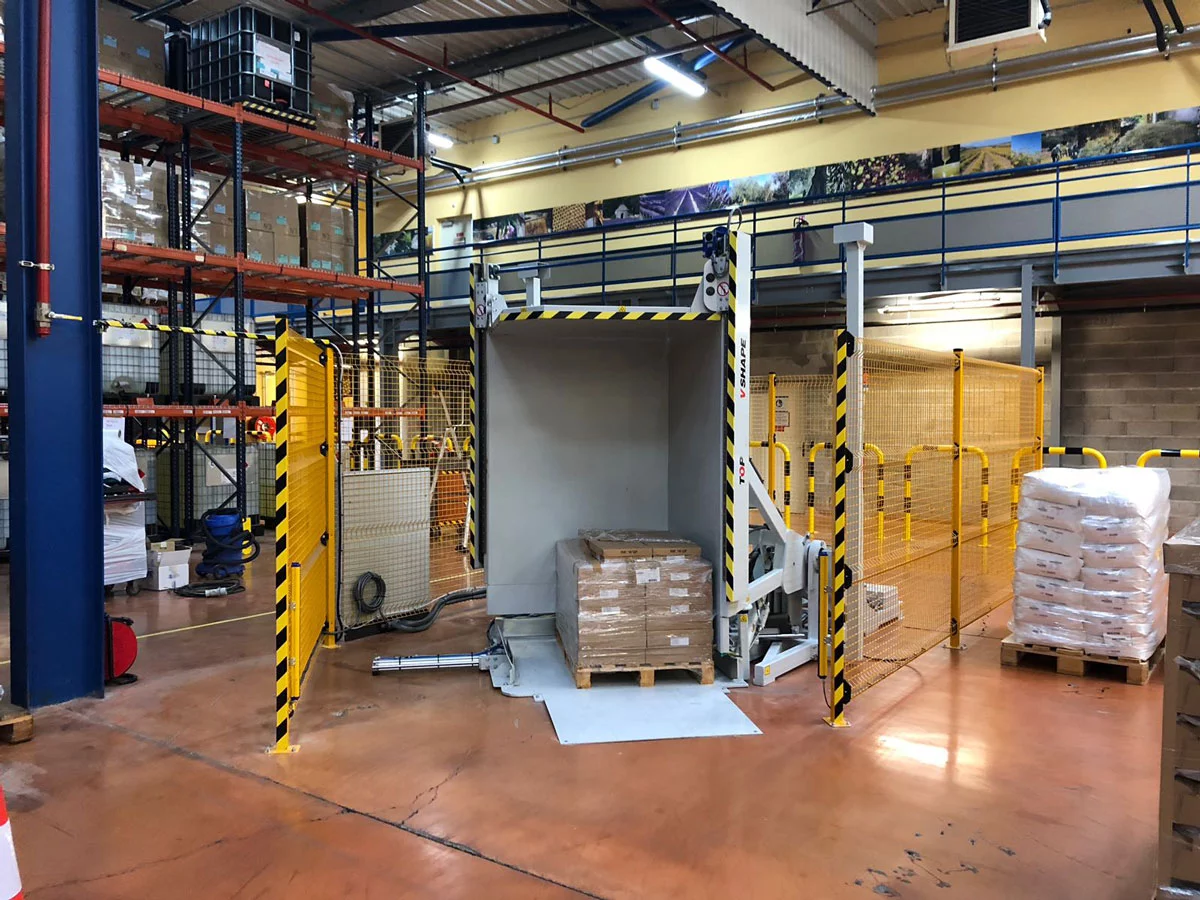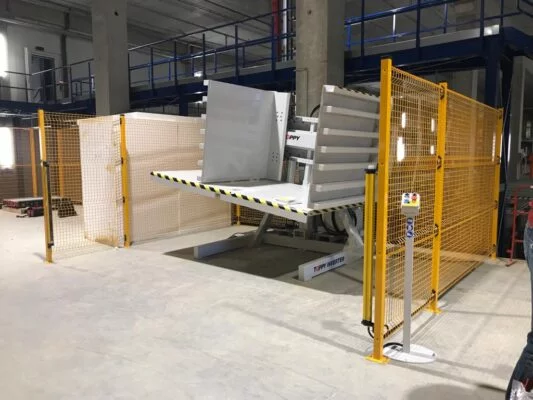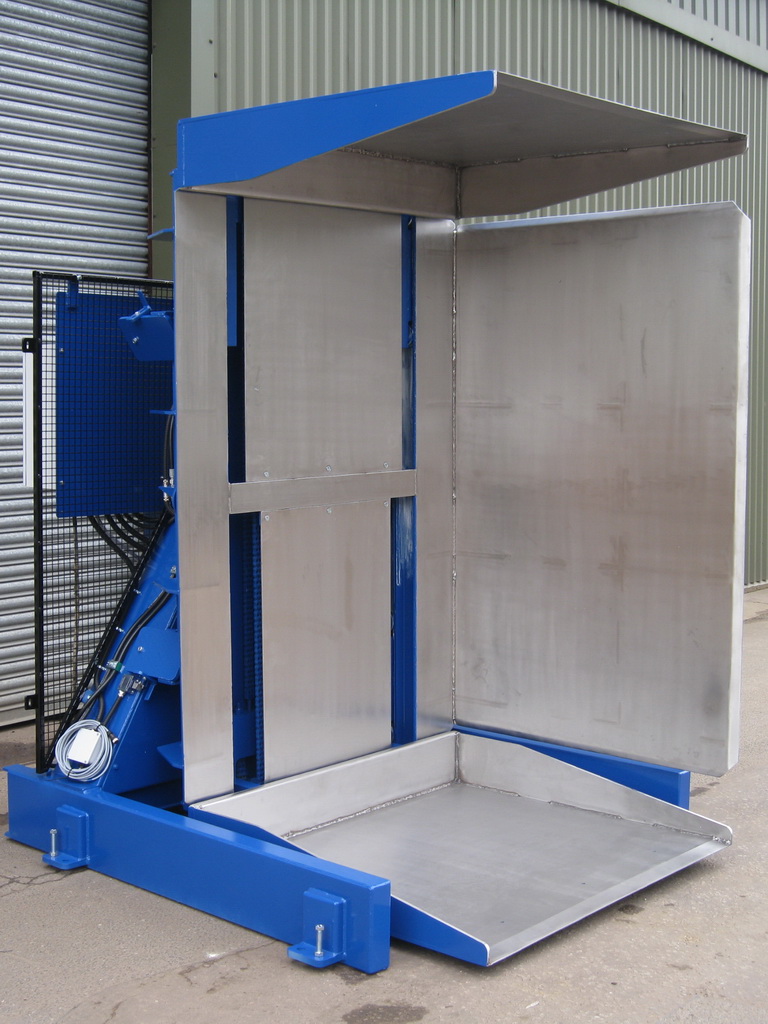Pallet Inverter Safety Tips for Romania Plants Facing Cost-Competitive Pallet Systems for Logistics Hubs
Romanian logistics hubs are facing intense competition. Every euro counts. But many businesses make a big mistake. They try to save money by cutting corners on equipment safety. This approach does not save money. It creates serious risks for your business. An unsafe pallet inverter can lead to costly downtime, severe injuries, and huge financial losses. Imagine your main pallet inverter breaking down during your busiest season. Or worse, an accident injures a valued employee. The direct costs of repairs and medical bills are high. The indirect costs are even higher. They include production halts, damage to your company's reputation, and rising insurance costs. These problems can seriously harm your business. The solution is not to avoid using pallet inverters. The solution is to master their safe operation. When you focus on strong safety rules, you change a potential problem into a reliable and efficient asset. This will make your business more competitive.
For Romanian plants, the most effective pallet inverter safety tips are simple but critical. You need complete operator training. You must perform strict checks before each use. You should create clear safety zones around the machine. And you must invest in machines with modern features like light curtains and pressure-sensitive plates. These steps are not expenses. They are investments that reduce accidents and improve efficiency. This is especially important in the cost-competitive environment of Romanian logistics hubs.

Now you have a general idea of what is needed. But the details are what make a real difference. I have spent my entire career in the packing machine industry. I started as an engineer on the factory floor and later built my own successful company, SHJLPACK. I have seen what works and what does not. I want to share the specific, actionable strategies I've learned from helping clients all over the world. These are the details that separate a good operation from a great one. Let’s look deeper into these safety essentials.
What are the most critical operator training protocols for pallet inverters?
You have invested in a high-quality pallet inverter. This is a great first step. But the machine is only as good as the person operating it. Many companies overlook proper training. They assume anyone can run the machine. This is a dangerous assumption. An untrained operator is more likely to make mistakes. These mistakes can damage the equipment, ruin products, and cause serious injuries. The costs of repairs, lost product, and downtime add up quickly. A structured training program is the only way to prevent this. It is an essential part of a safe and efficient workplace.
The most critical training protocols must cover several key areas. Operators need to understand the machine-specific controls and functions. They must know the load capacity limits and never exceed them. Proper procedures for loading and unloading pallets are crucial for both safety and efficiency. Every operator must know where the emergency stop buttons are and how to use them without hesitation. Finally, performing daily safety checks must become a routine habit. This training should not just be a one-time event. It needs to include hands-on practice and regular refresher courses to ensure the knowledge sticks.

A Deeper Look at Effective Training
A truly effective training program goes beyond a simple demonstration. It should be a formal process with clear stages. I always advise my clients to structure their training to build confidence and competence. This empowers employees and makes them feel valued, which reduces turnover and improves overall performance. Think about it this way: a well-trained operator is not just a machine user. They are the first line of defense against accidents and downtime. They can spot small problems before they become big ones.
Here’s a breakdown of what a comprehensive training curriculum should look like:
Phase 1: Classroom and Theoretical Knowledge
Before anyone touches the machine, they need to understand the principles behind it. This session should cover the "why" behind the rules.
- Machine Manual Review: Go through the manufacturer's manual section by section. Explain the function of each part.
- Safety Features: Detail every safety feature on your specific model. Explain what light curtains, safety cages, and pressure sensors do.
- Load Dynamics: Teach operators about center of gravity. Explain how an off-center or unstable load can create a hazard during the inversion process.
- Emergency Procedures: Discuss different emergency scenarios and the correct response for each. This includes machine malfunction, power failure, or a jammed load.
Phase 2: Hands-On Supervised Training
This is where theory meets practice. An experienced supervisor should guide the trainee through every step.
- Pre-Operation Checklist: The trainee must perform the daily check under supervision.
- Basic Operations: Start with empty pallets to get a feel for the controls. Then move to stable, simple loads.
- Complex Loads: Gradually introduce more challenging loads that are common in your facility. This could be unevenly stacked goods or heavy materials.
- Fault Simulation: The supervisor can safely simulate a minor issue, like a sensor alarm, to test the operator's response.
Phase 3: Assessment and Certification
Never assume training was successful. You must test and verify it.
- Written Test: A simple quiz to confirm understanding of the theoretical concepts.
- Practical Test: An evaluation where the operator must safely and efficiently perform a series of tasks.
- Formal Certification: Once they pass, provide a formal, documented certification. This creates a sense of professionalism and accountability.
Here is a sample training schedule:
| Training Module | Content | Duration |
|---|---|---|
| Theory | Manuals, Safety Systems, Load Stability | 4 Hours |
| Practical | Pre-use Checks, Basic & Advanced Operations | 8 Hours |
| Assessment | Written & Practical Exams | 2 Hours |
| Refresher | Annual Review and Re-certification | 4 Hours |
Keeping detailed training records is also vital. In a competitive market like Romania, this documentation is not just for internal use. It demonstrates your commitment to safety and quality to potential clients and regulatory bodies.
How can routine maintenance prevent major pallet inverter accidents?
Many plant managers see maintenance as a pure cost. They try to delay it or skip it to save money in the short term. This is a critical mistake, especially with powerful machinery like a pallet inverter. A pallet inverter uses immense force to lift and turn heavy loads. When you neglect its maintenance, you are allowing small issues to grow into huge problems. A worn hydraulic hose, a loose bolt, or a faulty sensor can lead to a sudden, catastrophic failure. This can cause the machine to drop a load, damage property, and injure workers. A proactive maintenance schedule is not a cost. It is your best insurance policy against accidents and unexpected downtime.
Routine maintenance prevents major accidents by finding and fixing problems before they cause a failure. Think about a car. You change the oil and check the tires regularly to avoid a breakdown on the highway. A pallet inverter is no different. A documented schedule for daily, weekly, and monthly checks ensures the machine stays reliable and safe for its entire lifespan. Catching a small hydraulic leak early costs a few euros to fix. Letting it fail could cost tens of thousands in damage and lost production.

A Deeper Look at Proactive Maintenance
A simple "look over the machine" is not maintenance. A real maintenance program is structured, documented, and proactive. It involves detailed checklists and a clear schedule. For my clients, I often help them develop a custom plan based on their specific machine and usage levels. A plant in a Romanian logistics hub running 24/7 will need a more aggressive maintenance schedule than a plant that uses its inverter a few times a day.
The goal is to move from reactive maintenance (fixing things after they break) to predictive maintenance (fixing things before they break). This approach dramatically increases equipment uptime, a key goal for any competitive business.
Daily Checks (Performed by the Operator)
These are quick visual inspections done at the start of every shift.
- Work Area: Check for debris, oil spills, or obstructions.
- Guarding: Ensure all safety fences and gates are in place and secure.
- Controls: Confirm all buttons, especially the emergency stop, are working.
- Visual Inspection: Look for any obvious signs of damage, like cracked welds or bent parts.
Weekly Checks (Performed by a Maintenance Technician)
These checks are more detailed.
- Hydraulic System: Check fluid levels and look for any leaks in hoses or fittings.
- Mechanical Parts: Inspect chains, sprockets, and bearings for wear. Lubricate as needed.
- Fasteners: Check and tighten any loose bolts or screws, especially on moving parts.
- Safety Sensors: Test light curtains and pressure mats to ensure they function correctly.
Monthly and Quarterly Checks (Performed by a Senior Technician or Specialist)
These are deep inspections of critical systems.
- Structural Integrity: Inspect the main frame and clamping tables for any signs of stress fractures or fatigue.
- Electrical System: Check wiring for any signs of wear or damage. Ensure control cabinet is clean.
- Hydraulic Fluid: Take a sample of the hydraulic fluid for analysis to check for contamination.
- Performance Test: Run the machine through a full cycle with a test load to check for smooth operation and proper timing.
Here is a sample checklist:
| Component | Daily Check | Weekly Check | Monthly Check |
|---|---|---|---|
| Emergency Stop | ✓ | ✓ | ✓ |
| Safety Fencing | ✓ | ✓ | ✓ |
| Hydraulic Fluid Level | ✓ | ✓ | |
| Check for Leaks | ✓ | ✓ | ✓ |
| Lubricate Chains | ✓ | ||
| Tighten Bolts | ✓ | ✓ | |
| Test Safety Sensors | ✓ | ||
| Inspect Frame Welds | ✓ |
Investing in IoT sensors can take this to the next level. Sensors can monitor hydraulic pressure, motor temperature, and vibration in real time. This data can be fed into your MES, triggering a maintenance alert before a component even fails. This is the future of industrial maintenance and a key step in any plant's digital transformation.
Which advanced safety features should Romanian logistics hubs look for in a new pallet inverter?
Using an old pallet inverter might seem like a good way to save money. But older machines often lack the modern safety technology that is standard today. Relying on this old technology exposes your team and your operation to risks that have been engineered out of new models. It is a false economy. The cost of a single serious accident will always be far greater than the cost of a new, safer machine. When you are looking to buy a new pallet inverter for your facility in Romania, investing in a model with advanced safety features is not a luxury. It is a critical step to protect your people and your profitability.
Romanian logistics hubs operating in a fast-paced environment should prioritize specific safety technologies. At a minimum, look for pallet inverters that come with full perimeter safety fencing. This physical barrier prevents people from accidentally walking into the machine's operating area. Inside this fence, light curtains or laser area scanners provide a second layer of protection. They create an invisible field that, when broken, immediately stops the machine. Also, look for machines with dual-channel safety circuits, pressure-sensitive clamping plates, and multiple, easy-to-access emergency stop buttons. These features work together to create a much safer operating environment.

A Deeper Look at Modern Safety Systems
When I started in this industry, safety features were often basic mechanical guards. Today, they are sophisticated electronic systems that make machines smarter and safer. Understanding these features will help you make a better investment decision. You are not just buying a machine; you are buying a safe system of work. For a forward-thinking owner like Javier Morales, investing in this technology is an investment in stability and long-term return.
Let's break down the most important features:
Perimeter Guarding
This is the first line of defense.
- Safety Fencing: This is typically a wire mesh fence, at least 2 meters high, that completely encloses the machine's movement area. It prevents unauthorized access.
- Interlocked Access Gates: Any door or gate in the fence must have an interlock switch. If the gate is opened while the machine is running, the interlock immediately sends a stop signal to the machine's control system. The machine cannot be restarted until the gate is closed and the system is reset from a safe location.
Presence Sensing Devices
These devices detect when a person has entered a dangerous area.
- Light Curtains: These are the most common solution. They consist of a transmitter and a receiver that create a multi-beam grid of infrared light. If any beam is broken, the machine stops. They are ideal for the loading and unloading areas where a physical gate is not practical.
- Laser Area Scanners: These are more advanced. A single device can monitor a complex, user-defined area. They can be programmed with a "warning zone" and a "stop zone." If someone enters the warning zone, a light or horn might activate. If they enter the stop zone, the machine halts immediately.
Machine Control Safety
These features are built into the machine's core logic.
- Dual-Channel Safety Circuits: This is a crucial concept. For critical safety functions like emergency stops or light curtains, the wiring runs through two separate channels. The safety controller constantly checks that both channels are working. If one channel fails (e.g., a wire breaks or a relay sticks), the system can still safely stop the machine. A single-channel system would not detect this failure, creating a hidden danger.
- Pressure-Sensitive Clamping: The plates that hold the load should have adjustable and monitored pressure. The system ensures just enough pressure is applied to hold the load securely without crushing it. If the pressure drops unexpectedly, it can trigger an alarm or stop the machine.
Here is a comparison of basic vs. advanced safety:
| Feature | Basic Safety (Old Machines) | Advanced Safety (New Machines) | Benefit |
|---|---|---|---|
| Guarding | Simple railings, no interlocks | Full fencing with interlocked gates | Prevents access to danger zones |
| Sensing | None | Light curtains or laser scanners | Stops machine if a person enters |
| Controls | Single E-Stop circuit | Dual-channel safety circuits | Failsafe design, more reliable |
| Clamping | Fixed high pressure | Monitored, adjustable pressure | Protects product, adds safety layer |
Investing in these advanced features reduces risk, which in turn can lower insurance premiums. It also demonstrates to your employees that you care about their well-being, which improves morale and productivity. It's a key part of becoming a modern, competitive business.
How does integrating pallet inverters with automated systems impact overall safety?
In many warehouses and factories, the area around a standalone pallet inverter is a major hotspot for accidents. Forklifts are constantly moving in and out, delivering and removing pallets. This manual interaction creates many opportunities for things to go wrong. A forklift could collide with the inverter, damage the load, or even hit a nearby worker. The operator might be focused on the machine's controls and not see an approaching vehicle. The solution is to remove as much of this chaotic manual interaction as possible. Integrating the pallet inverter into a larger automated system, like a conveyor line, completely changes the safety dynamic for the better.
Integrating pallet inverters with automated guided vehicles (AGVs) or conveyor systems dramatically improves safety. It does this by removing forklift traffic from the machine's immediate operating area. The workflow becomes controlled, predictable, and orderly. Pallets are fed into the inverter and taken away by the automated system. This eliminates the risk of collisions and removes the need for operators to be in close proximity to moving forklifts and the inverter at the same time. This automation reduces the chance of human error, which is a factor in most workplace accidents.

A Deeper Look at Safe Integration
Full integration is a key step in a facility's digital transformation and a core part of creating a "smart factory." It is about making different pieces of equipment talk to each other to create a seamless, safe, and efficient process. From my experience helping clients in the steel industry with coil packing lines, I have seen firsthand how powerful this can be. We don't just sell a machine; we provide a "TOTAL SOLUTION" that looks at the entire production flow.
Let's explore how this works in practice.
Integration with Conveyor Systems
This is a very common and effective solution.
- Infeed and Outfeed Conveyors: Roller or chain conveyors are installed to bring pallets directly to the inverter and take them away after the process.
- Automated Centering: Sensors on the conveyor can ensure the pallet is perfectly centered before it enters the inverter, which is crucial for a stable inversion.
- Handshaking Signals: The conveyor and the pallet inverter are electronically connected. The conveyor will not feed a pallet until the inverter signals it is ready. The inverter will not start its cycle until the conveyor signals the pallet is in the correct position. This electronic "handshake" prevents crashes and ensures smooth operation. The entire process is contained within a guarded area, with no need for human or forklift interaction.
Integration with AGVs or AMRs
This offers even more flexibility.
- Automated Guided Vehicles (AGVs): These follow set paths, like magnetic tape or lasers, to transport pallets. An AGV can be programmed to pick up a pallet, deliver it to the inverter's designated station, and then pick it up after the pallet exchange.
- Autonomous Mobile Robots (AMRs): These are even smarter. They use maps and sensors to navigate dynamically, even around unexpected obstacles. An AMR can be called by the central MES system to service the pallet inverter as needed.
- System Integration: The factory's Warehouse Management System (WMS) or Manufacturing Execution System (MES) orchestrates the whole process. It tells the AMR to get a specific pallet and take it to the inverter. The inverter then performs its task and signals the MES when it is done. The MES then dispatches another AMR to retrieve the finished pallet.
Here is a simple comparison of the workflows:
| Process Step | Manual Workflow | Integrated Workflow | Safety Impact |
|---|---|---|---|
| 1. Pallet Arrival | Forklift drives to inverter | Pallet arrives on conveyor/AGV | Eliminates forklift traffic |
| 2. Positioning | Operator guides forklift driver | Automated centering | Reduces risk of misalignment |
| 3. Inversion | Operator starts machine | System starts automatically | Operator is outside the fence |
| 4. Pallet Removal | Forklift enters to retrieve | Conveyor/AGV removes pallet | Eliminates forklift traffic |
This level of automation not only boosts safety but also provides valuable data. Every cycle is logged, which helps with predictive maintenance and productivity analysis. For a leader like Javier, who wants to achieve 95% equipment uptime and deploy a full MES, this kind of integration is not just a nice-to-have; it is an essential part of his strategic goals.
My Insight: Why Safety is Your Most Profitable Investment
I remember a client a few years ago. He was a steel plant owner in Eastern Europe, a practical and sharp businessman. He was facing challenges very similar to those in Romania today: high energy costs, aging equipment, and intense market pressure. He needed a new wrapping solution for his steel coils, and he contacted us.
Initially, our conversations were all about price. He wanted the cheapest machine that could do the job. That is a common starting point. But I knew from my own journey—from being an engineer on the floor to owning a factory—that the sticker price of a machine is only a small part of the story. I asked him if I could visit his plant. He agreed.
When I walked his factory floor, I saw the full picture. I saw skilled workers manually maneuvering heavy steel coils near old, unguarded machinery. I saw the potential for accidents everywhere. Their current process was slow and created bottlenecks that limited their entire output.
We sat down again. I told him, "My goal isn't to sell you the cheapest machine. My company, SHJLPACK, provides a TOTAL SOLUTION. Let's look at your entire process." We designed a system that included a new coil wrapping machine, but we also integrated it with automated conveyors. We surrounded the entire work cell with modern safety fencing and light curtains. We spent two full days training his team, not just on how to operate the machine, but on how to maintain it safely.
He was hesitant about the higher initial investment. But he trusted us. Six months later, he called me. He told me an operator had accidentally walked toward the running machine, and the light curtain stopped it instantly, preventing a serious injury. He also said that because the new automated system was so much smoother and more reliable, their output had increased by 15%, and downtime from that part of the line was almost zero. He said, "Vincent, that safety system paid for itself in the first six months, just from the increased production, not to mention the accident it prevented."
This is why I do what I do now. The packaging industry gave me so much and allowed me to achieve financial independence. Now, my mission is to share what I've learned to help others succeed. Safety is not an expense you can cut. It is the very foundation of a stable, efficient, and profitable operation. In a competitive market, it is your greatest strength.
Conclusion
Prioritizing pallet inverter safety with training, maintenance, and modern features is not a cost. It is the key to unlocking reliability, efficiency, and competitiveness for any logistics hub.




